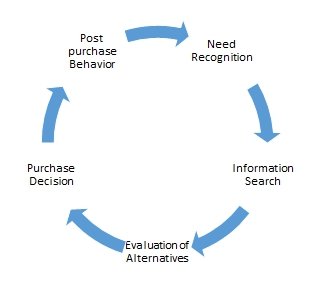The marketing strategies used by an organization play a pivotal role towards determining the success or failure of the organization. In order for an organization to market its products and services successfully, it must research and understand the needs of the consumers, and use this information to develop products and services that satisfactorily address those needs.
One way of achieving this aim is by developing models that evaluate the consumer buying behavior within a given market. This paper shall describe the steps followed by consumers in the process of buying oatmeal manufactured by Quaker Oats Company. The cultural factors that influence consumers to buy this product shall also be discussed.
There are five steps that consumers take in order to make a conclusive purchasing decision. The rate at which consumers pass through these stages depends on the price, place, promotion and product being sold. Below is a graphical representation of the consumer buying behavior:

Figure 1: Consumer Buying Behavior Model
In regard to the selected product (Oatmeal), the consumers recognizes the need or problem. This can be triggered by an internal stimuli (hunger), which drives the consumer towards buying this product. After identifying the need or desire, the consumer may or may not look for information about the product.
If the consumer has used the product before, he/she may buy the product again. However, if the consumer has not yet used the product, he/she may obtain the information about this product from personal or commercial sources. For the oatmeal, commercial sources such as advertisements, packaging and dealers could be useful for potential consumers.
The information gathered gives consumers a set of brand choices. In order to select the preferred brand, consumer compare and contrast the brand from a logical or evaluative processes. Some may use calculations (price and content preferences) or choose the product brand on impulse or intuition.
After evaluating the alternatives, the consumer ranks the brands and decides which one to buy. The purchase decision is based on the price, income and expected benefits of the product. As such, the consumers may buy the oatmeal as a result of its competitive price, its health benefits and its impact on the consumer’s pocket.
The post purchase behavior of consumers refers to the attitude and perceptions the consumers have in regard to the product’s ability to satisfy the identified need. During this step, consumers weigh their expectations against the performance of the product. If the gap between these two factors is large, the consumers will be disappointed, but if the gap is small, the consumers will be satisfied and delighted with the product.
Cultural influences on consumers Buying Behavior
According to Sheth (2011), cultural factors have a significant impact on a consumer’s buying behaviors. Cultural factors largely influence the wants and behaviors of an individual in regard to value systems, perceptions, material comfort and practicality among others (Sheth, 2011). In order to sell the oatmeal profitably, due consideration should be given to the culture, subculture and social classes within a given market.
Marketers should do research in order to ascertain the income levels of the selected market segment, the value system of the consumers and the impact family and friends have on an individual’s purchasing process. Understanding how the aforementioned cultural factors impact buying behaviors will enable marketers to come up with a price and product that meets the consumer’s cultural expectations.
In addition, such an understanding will enable marketers to promote the product in a manner that guarantees success. Failure to consider these factors may lead to dissatisfaction among the consumers, and losses to the manufacturers.
Reference
Sheth, J. (2011). Models of Buyers Behavior: Conceptual, Quantitative and Empirical. Illinois: Marketing Classics Press.